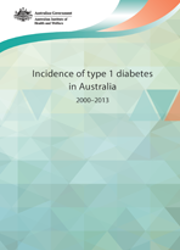Summary
Type 1 diabetes is a lifelong autoimmune disease requiring management with insulin to ensure blood glucose levels remain within a safe range. If left untreated, or improperly managed, type 1 diabetes can lead to many health complications.
This report uses the latest available data from the National (insulin-treated) Diabetes Register to examine the incidence—that is, the number of new cases—of type 1 diabetes in Australia.
- From 2000 to 2013 there were 31,895 new cases of type 1 diabetes in Australia, with 2,323 of these in 2013.
- The rate of type 1 diabetes has remained stable for more than a decade, at around 10 to 13 cases per 100,000 population each year.
- The incidence of type 1 diabetes was higher for males than for females—12 per 100,000 compared with 9 per 100,000, respectively, in 2013.
- More than half of all new cases of type 1 diabetes were in people aged under 18 years.
- Rates were 3 times as high among 0–14 years olds (24 per 100,000 population) compared with those aged 15 and over (8 per 100,000 population).
- The rate of type 1 diabetes was lowest in the Northern Territory, at 6 per 100,000 population, compared with other states and territories, which ranged from 11 to 13 per 100,000 population between 2000 and 2013.
- From 2001–2013, the rate of type 1 diabetes was lower in remote and very remote areas compared with other areas of Australia—7 cases per 100,000 population compared with 11–13 per 100,000, respectively.
- Aboriginal and Torres Strait Islander people had a lower incidence of type 1 diabetes than non-Indigenous Australians: 7 per 1000,000 population and 10 per 100,000, respectively, in 2005–2013.
Over 2,000 new cases of type 1 diabetes in 2013
Incidence of type 1 diabetes remained relatively stable between 2000 and 2013
Rate of type 1 diabetes lowest in the Northern Territory
Health inequalities—type 1 diabetes does not discriminate
End matter: Data collection



